
Eriophyllum lanosum, the white woolly daisy or white easterbonnets, is a spring wildflower in the sunflower family. It grows in the eastern Mojave Desert and the Sonoran Desert in the southwestern United States and northwestern Mexico.

Banksia shuttleworthiana, commonly known as bearded dryandra, is a species of low, spreading shrub that is endemic to Western Australia. It has thin, woolly-hairy stems, linear pinnatisect leaves, creamy brown to purplish flowers in heads of about forty and later, only a few egg-shaped follicles in each head.

Anemone parviflora, the northern anemone, or small-flowered anemone, is a herbaceous plant species in the genus Anemone and family Ranunculaceae. Plants grow 10 to 30 cm tall, from a thin, 2 mm thick rhizome. Stem leaves without petioles, basal leaves few with long petioles and deeply 3-parted. Plants flowering late spring to mid summer with the flowers composed of 5 or 6 sepals normally white or soft bluish colored, 8 to 13 mm long. The plants produce one peduncle with one solitary flower. Fruits in heads ovoid in shape, 10 mm long or less, fruits densely woolly, not winged and with straight 1 to 2.5 mm long beaks.
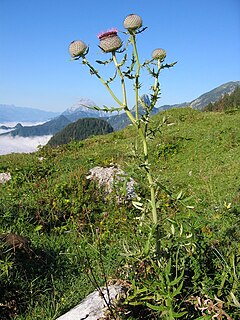
Cirsium eriophorum, the woolly thistle, is a herbaceous biennial species of the genus Cirsium. It is widespread across much of Europe. It is a large, biennial herb with sharp spines on the tips of the leaves, and long, woolly hairs on much of the herbage. Flower heads are large and nearly spherical, with spines on the outside and many purple disc florets but no ray florets.
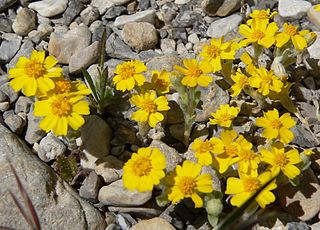
Eriophyllum wallacei is a North American flowering plant in the daisy family known by the common names woolly daisy and woolly easterbonnets. It grows in the southwestern United States and northwestern Mexico.

Cirsium scariosum is a species of thistle known by the common names meadow thistle, elk thistle and dwarf thistle. It is native to much of western North America from Alberta and British Columbia south to Baja California. There are also isolated populations on the Canadian Atlantic Coast, on the Mingan Archipelago in Québec.

Quercus turbinella is a North American species of oak known by the common names shrub oak, turbinella oak, shrub live oak, and gray oak. It is native to Arizona, California, New Mexico, Utah, Colorado, and Nevada in the western United States. It also occurs in northern Mexico.
Packera bernardina is a rare species of flowering plant in the aster family known by the common name San Bernardino ragwort.
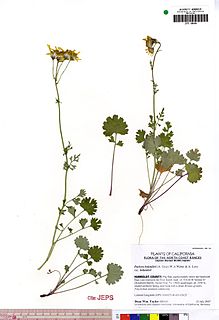
Packera bolanderi is a species of flowering plant in the aster family known by the common names Bolander's ragwort and seacoast ragwort. It is native to the west coast of the United States from Washington to northern California, where it grows in wet coastal forests and woodlands. There are two varieties of the species which differ slightly in morphology and habitat occupied; these varieties have been considered separate species by some authors. The var. bolanderi has thicker leaves, occurs farther south, and occupies more open types of habitat, than does var. harfordii. This plant in general is a perennial herb producing one to three stems up to half a meter tall. The basal leaves have blades up to 12 centimeters long which are divided into several lobes and borne on long, thin petioles. Leaves growing farther up the stem are smaller and have more lobes on their blades. The inflorescence contains several flower heads, each lined with dark green phyllaries. The head contains many golden yellow disc florets and generally either 8 or 13 yellow ray florets each over a centimeter long. The fruit is an achene tipped with a pappus of bristles.

Packera cana is a species of flowering plant in the aster family known by the common name woolly groundsel. It is native to western and central North America, where it can be found in a wide array of habitat types at all elevations from grassland to the alpine climates of mountain peaks.

Packera greenei is a species of flowering plant in the aster family known by the common name flame ragwort. It is endemic to northern California, where it is known from the North Coast Ranges and southern Klamath Mountains. It is a resident of dry mountain scrub habitat, often on serpentine soils.
Packera ionophylla is an uncommon species of flowering plant in the aster family known by the common name Tehachapi ragwort. It is endemic to California, where it is known from the Tehachapi Mountains, the San Gabriel and San Bernardino Mountains, and Alamo Mountain near the Grapevine. It grows in mountain forest habitat.
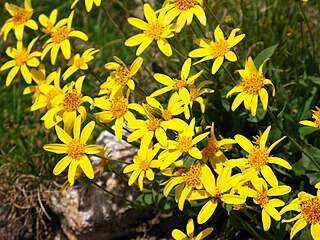
Packera werneriifolia, known by the common names alpine rock butterweed and hoary groundsel, is a species of flowering plant in the aster family. It is native to the western United States in the Sierra Nevada mountain habitat in subalpine and alpine climates, including forests and barren talus.
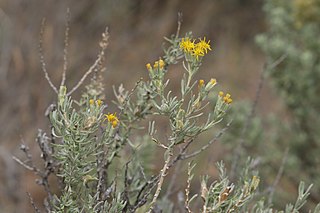
Tetradymia argyraea is a species of flowering plant in the aster family known by the common names spineless horsebrush and gray horsebrush. It is native to western North America.

Packera franciscana is a rare species of flowering plant in the aster family known by the common name San Francisco Peaks groundsel, or San Francisco Peaks ragwort. It is endemic to Arizona in the United States, where it is known only from the San Francisco Peaks in Coconino County. It is threatened by recreational activities in its habitat. It is a federally listed threatened species of the United States.
Packera castoreus is a rare species of flowering plant in the aster family known by the common names Beaver Mountain groundsel and Beaver Mountain ragwort. It is endemic to Utah in the United States, where it occurs only in the Tushar Mountains.
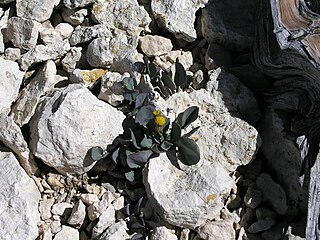
Packera malmstenii is a rare species of flowering plant in the aster family known by the common name Podunk ragwort. It is endemic to Utah in the United States, where there about 19 occurrences in the southwestern part of the state.
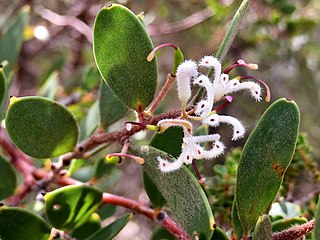
Hakea lasiantha, commonly known as the woolly-flowered hakea, is a shrub in the family Proteacea endemic to an area along the south coast in the South West and Great Southern regions of Western Australia.

Packera schweinitziana, commonly called New England groundsel, is a species of flowering plant in the aster family (Asteraceae). It is native to eastern North America, where it is primarily found in eastern Canada and the northeastern United States, with disjunct populations in North Carolina and Tennessee on Roan Mountain. Its natural habitat is in sunny, wet areas, often in acidic soil. In the southeastern United States, its habitat is restricted to Appalachian balds.

Dissocarpus paradoxus is a shrub species of inland Australia, also known by the common names of cannonball burr or curious saltbush.


















